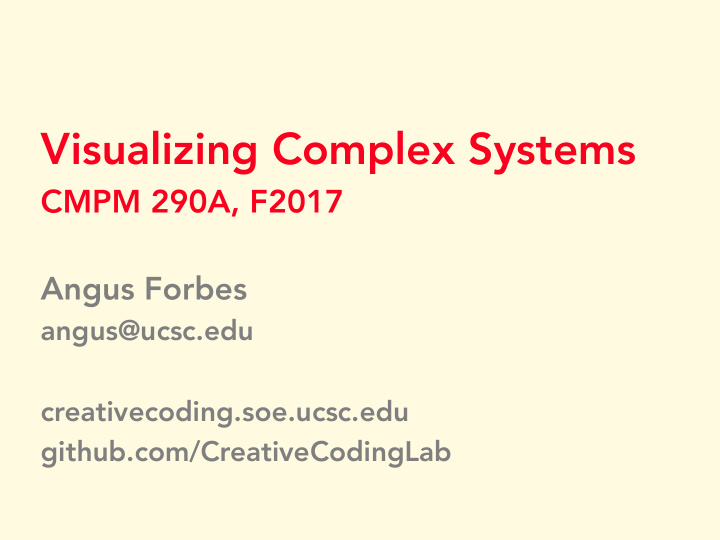



Visualizing Complex Systems CMPM 290A, F2017 Angus Forbes angus@ucsc.edu creativecoding.soe.ucsc.edu github.com/CreativeCodingLab
About Me - New asst. professor in UCSC’s Computational Media Department - Teaching courses on data visualization and computer graphics
Research Interests Main areas: - Visualization & Visual Analytics - Computer Graphics - VR / AR - New Media Arts Also: - Applied ML, Digital humanities, HCI, Network science, Data sonification, etc.
Research Communities - ACM SIGGRAPH 2018 Arts Papers Chair - IEEE VIS Organizing committee member for 2013-2017 - IEEE VIS Arts Program, General Chair, 2013-2017 - ACM/EG Computational Aesthetics Papers Chair 2016; Arts Chair 2015 - Also contribute to ISEA, VR, NIME, ICMC, CHI, UIST, and others
Recent Research Projects - Focus on novel ways to represent and analyze dynamic, complex networks - Collaborate with scientists to design visualization tools to make it easier to reason about their data - Enormous and essential opportunity for creative, computational researchers and artists to investigate issues related to “big data”
Dynamic Influence Networks
NeuroCave
Annotating Complex Natural Language Phenomena
Creative Research - New forms of representation and interaction - AR / VR, Deep Learning - Design thinking / Graphic design / Interactive design
Inviso
Deep Illumination
Computational Art - Using computational media to create interactive artworks - Visualizing archives, cultural datasets - Algorithmic, generative graphics
Fluid Automata
Macondo
Poetry Chains
Video Granular Synthesis
Riverwalk
Creative and Critical Visualization https://creativecoding.soe.ucsc.edu https://github.com/CreativeCodingLab http://angusforbes.com http://visap.uic.edu/2017
What is this class about? Information Visualization Effective ways to interact with and represent different types of data – often involves designing new techniques that can be applied in many contexts Visual Analytics Effective use of visual interfaces to solve complex problems - often involves a combination of techniques specific to a particular industry or domain
Viegas and Wattenberg, 2012 “Wind Map”
Holten, 2006 “Hierarchical Edge Bundling”
Riche and Dwyer, 2012 “Compact Rectangular Euler Diagrams”
Shneiderman, 1992 “Treemaps”
Dang & Forbes, 2017 “Cactus Tree”
Partl et al., 2014 “ConTour”
Kamaleswaran et al., 2016 “PhysioEx”
Zhao et al., 2016 “PivotSlice”
Dang & Forbes, 2017 “BioLinker”
(Interactive) Infographics - Generally static or have a limited set of interactions - Often highlight particular elements to encode a specific narrative - Normally utilize a minimalist palette in order to help viewer focus on important concepts
Minard, 1869 “Napoleon's 1812 Invasion of Russia”
Nightengale, 1858 “Diagram of the Causes of Mortality in the Army...”
Parlapiano & Sanger-Katz, 2016 “Shifts in Power”
What will you learn? Science Data science: Extracting insight from data, especially “big data” Scientific method: Observation, data collection, hypothesizing, experimenting, testing, analyzing, communcating Engineering Coding + software development, D3.js, Javascript, working in teams
What will you learn? Visualization - How to creatively and effectively choose visual encodings ( color , shape , motion , etc.) for different types of data ( tabular , network , textual , geographic , temporal , etc.); - How to develop tools to support a range of visualization tasks ( analysis , annotation , exploration , comparison , etc.); - How to think of visualization projects in terms of the larger context of the needs and goals of the intended audience
How will you learn? Projects & Presentations P1, “Quantified Self” – Test out different visual techniques for a (relatively) straightforward dataset - Individual project P2, “Integrated Datasets” – Explore how to integrate multiple techniques to find relationships between data from multiple datasets – Group project P3, “Unsolved Problems” – Develop new techniques to represent complex data to solve complex problems – Group project
How will you learn? Assignments & Quizzes Read textbook and articles + study contemporary programming techniques for information visualization Participation Learn from and teach each other; make sure you understand the material; find ways to make the material meaningful to you
Project 1 For this assignment, creativity more important than accuracy... Grading like a diving or gymnastics competition – difficulty and originality of dive or routine is taken into consideration...
Project 1 Ideas for how to think of an interesting data set to collect: - Find something meaningful that: piques your curiosity, that constantly annoys you, that amuses you, that you tend to notice - What is a special skill or set of experiences unique to you? What thoughts or perspectives do you have that are not shared by everyone?
S. Posavec & G. Lupi, 2015 “Dear Data”
Giorgia Lupi, 2015 “Dear Data”
G. Lupi, 2015 “Dear Data”
S. Posavec, 2015 “Dear Data”
S. Posavec, 2015 “Dear Data”
N. Felton, 2009
N. Felton, 2010
Homework for Tuesday, 10/10 - Read chapter 1 & 2 of “Network Science,” by Albert-László Barabási http://barabasi.com/networksciencebook/
Homework for Tuesday, 10/10 - Go through chapters 1 through 13 of “Interactive Data Visualization for the Web, 2nd Edition,” by Scott Murray http:// proquest.safaribooksonline.com.oca.ucsc. edu/book/databases/business- intelligence/9781491921296
Homework for Tuesday, 10/10 - Collect data for Project 1, be prepared to present hand-drawn “Dear Data”-style data visualization - Set up D3.js environment and pick one example of your choice from bl.ocks.org to explain in class 10/10
Project 1, due Tuesday, 10/17 Details to be provided soon, but basically: - Iterate on hand-drawn data visualizations - Create an interactive version in D3.js
Slack channel Main form of class communication: ucsc-creativecoding.slack.com
Recommend
More recommend